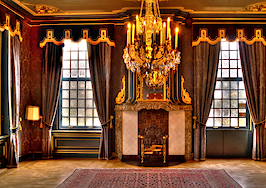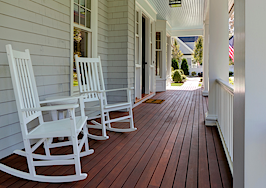Looking for more advice? Check out Inman’s New Agent Essentials.
American housing styles have changed, and continue to change, throughout the country and as homeowners’ tastes and lifestyles have evolved. As the country has undergone industrial and economic changes, both good and not so good, housing styles have adapted out of necessity.
In this series, I will walk you through the predominant housing styles of the past 12 decades, beginning in 1900. A basic understanding of each architectural style that defines a decade will position you as a knowledgeable agent with your clients and make searching for a home with your buyers easier for everyone.
Real estate agents are required to have so much information at their fingertips, ready to answer buyers’ and sellers’ questions, calm their nerves, and assure them that you, their agent, have their best interests at heart. In addition to being well-versed in mortgage interest rates, local politics and zoning, school districts, traffic patterns, sidewalks and sanitation pickups, it helps if Realtors can discuss housing styles and periods with some degree of confidence.
Sometimes a little research can help an agent to understand a client’s needs; other times careful observation of a building’s style of window, roofline, floorplan or front door will help to identify the provenance of the house. Your knowledge will impress clients, indicating that you, their agent, are well-versed and articulate in architecture and house styles.
In some instances, the best way to understand a period of housing is to think of what was happening in history at a particular time, who was president, or what war our country was fighting. An understanding of history is particularly useful when understanding and explaining to clients the difference between prewar and postwar housing. Clearly, it is also helpful to identify which world war is being referenced to assure accuracy.
The stock market crash and Great Depression impacted everything that happened in the United States between 1929 and 1930. This was a period of great uncertainty, reflected in houses called bungalows. They were smaller and occupied one floor only.
In addition, these homes no longer housed servants, and suburban developments sprang up. Apartment houses in U.S. cities, some of which featured lavish full-floor houses, were divided into multiple apartments. Some of these divisions were seamless, with new floorplans working for smaller families, while others were awkward, with long corridors, or servants’ rooms turned into bedrooms for family members.
Floorplans and building materials in the 1930s were simpler and more straightforward. Houses featured a front room or parlor accessible from the front hall and a rear parlor or living room and kitchen on the first floor. Upstairs, if the house had a second story, were two bedrooms, a bathroom and a third smaller bedroom used as a nursery.
Some houses had a chalet-style pitched room with a “half bedroom” in the attic or third floor. Garages were found near houses, typically in the yard behind the house, sometimes accessible via an alley. Garages did not become commonplace in houses until the 1940s.
New style kitchens were styled to be attractive to the modern homemaker who did her own cooking and laundry without the benefit of servants. Kitchens contained freestanding hot water “boilers” and modern wringer washing machines were housed here as well. Yards, accessible from the kitchen, were used for drying laundry, as well as gardens. Interiors in the 1930s featured wood paneling, parquet wood floors and tile fireplace surrounds.
Materials used for exterior construction include brick, half timbers typical of the Tudor style, and mortar into which crushed stone was mixed, called “pebble dash.” A lime-based mortar was applied over bricks, making houses of this period warmer and waterproof.
Semi-detached houses, or two houses that share a party wall, began to make an appearance, as a more economical style and more efficient use of space. As these houses had three exposures, they had windows on only three sides. This made them more economical to construct and more efficient to heat, as the elements only impacted one side, and the front and rear.
Despite economic woes, there were style trends evident in the 1930s, mainly a combination of Tudor, Jacobean and Elizabethan architectural movements, coming from Great Britain, termed the Tudorbethan Style. A pastiche of architectural influences, these houses sported elements from all three periods, in reaction to the Arts and Crafts movement.
Areas of herringbone brickwork, tiled walls, weatherboards and wood-framed windows with iron casements and diamond-shaped leaded panes are clues to a house from the 1930s. Roofs were red clay tiles rather than slate, and chimney stacks were more elaborate. Front porches made way for small overhangs over a front door — often a simple hood with console brackets or gables.
Front doors were oak with iron nails and fittings in the 1930s, while second-story bay windows had angled or rounded sides. Larger houses were still constructed for those not affected by the Depression and Inglenook fireplaces, with built-in seating and upholstered benches, were typical.
The late 1930s saw the rise of the “Hollywood Regency” style, popularized by America’s love affair with the movies.
During these dire times, the public craved entertainment, and stylized modern styles were the antidote to a colorless life. The first skyscrapers began to appear in Chicago and New York at the end of the 1930s, which would forever change the urban skyline of America. Skyscrapers were born due to steel becoming a new material used in construction, water pumps, and the elevator.
Some of the defining 1930s aesthetic elements may still be in evidence in houses today, but as windows, doors and roofing materials deteriorate over time, they may have been replaced with less authentic finishes or aluminum double-hung or casement windows. A poorly maintained house in original condition may be expensive to restore, but may be just the project that a buyer with historic architecture sensitivity may long for.
If your buyer is not interested in research, shopping for materials, and interviewing contractors, steer clear of a home from this period.
Real estate agents who know housing styles, even if only a little bit about each period, will have an advantage when dealing with knowledgeable buyers and sellers. There is always a market for architecturally pure and well-preserved houses. This type of housing stock will sell for a premium to the right customer base. It is up to the savvy Realtor to recognize the style and price the property accordingly.
Gerard Splendore is a licensed associate real estate broker with Warburg Realty in New York. Connect with him on LinkedIn.













